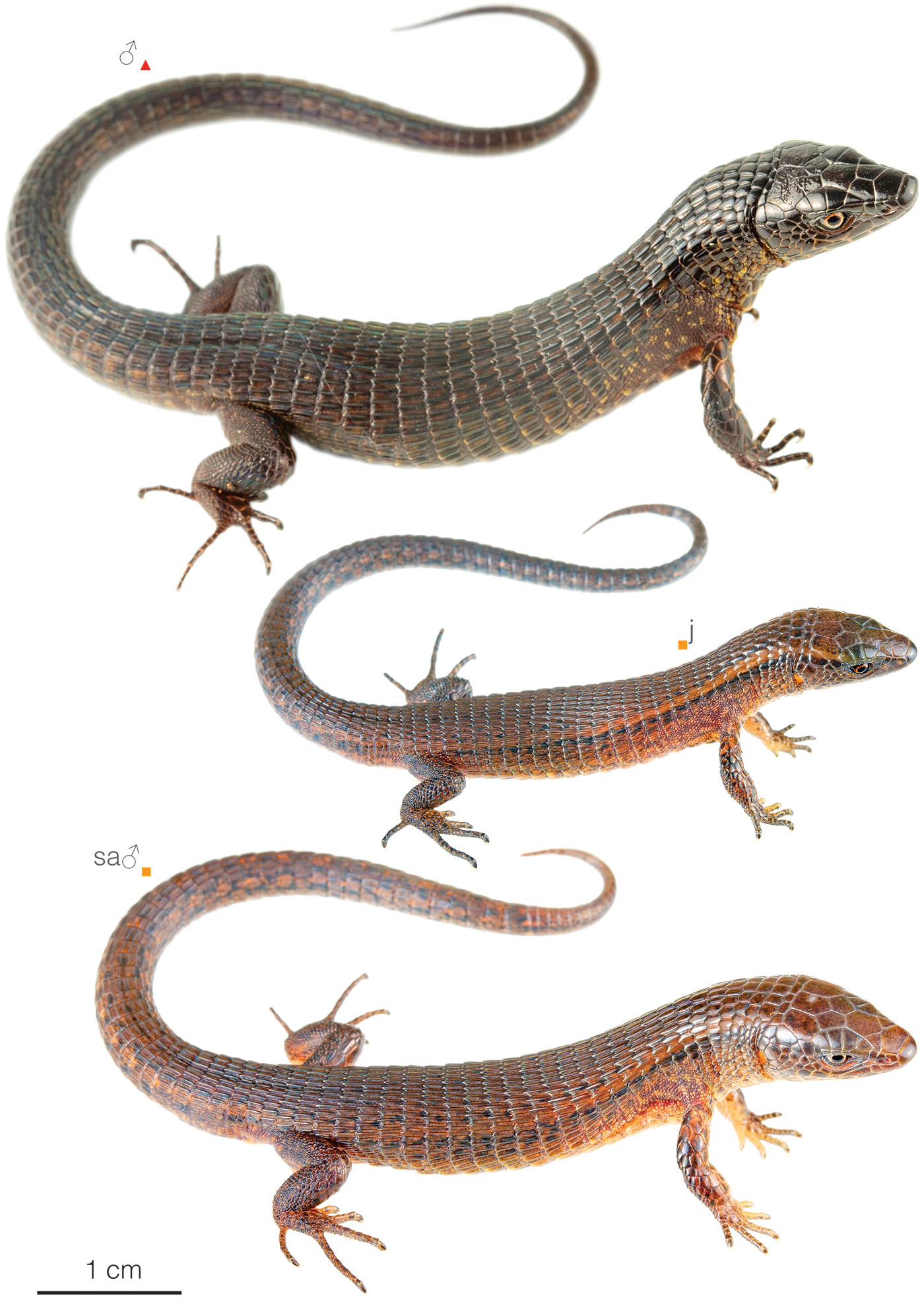Published April 13, 2023. Updated December 12, 2023. Open access. | Purchase book ❯ |
Striped Shade-Lizard (Alopoglossus bilineatus)
Reptiles of Ecuador | Sauria | Alopoglossidae | Alopoglossus bilineatus
English common name: Striped Shade-Lizard.
Spanish common name: Lagartija sombría listada.
Recognition: ♂♂ 16.3 cmMaximum distance from the snout to the tip of the tail. Snout–vent length=6.7 cm. ♀♀ 12.3 cmMaximum distance from the snout to the tip of the tail. Snout–vent length=5.4 cm..1 The Striped Shade-Lizard (Alopoglossus bilineatus) is a small, slender lizard with a brown dorsum and a pair of light dorsolateral stripes that are bordered above and below by a narrower dark brown edge.2,3 This species can be distinguished from the other shade lizards in western Ecuador by having strongly keeled and overlapping hexagonal dorsal scales (Fig. 1). In A. harrisi and A. viridiceps, the dorsal scales are mucronate (ending abruptly in a sharp point) and are not hexagonal.4,5 In A. gorgonae, the scales are striated and not strongly keeled.3

Figure 1: Individuals of Alopoglossus bilineatus from Ecuador: Manduriacu Reserve, Imbabura province (); Balzapamba, Bolívar province (). sa=subadult, j=juvenile.
Natural history: Alopoglossus bilineatus is an extremely rareTotal average number of reported observations per locality less than three. cryptozoic (preferring moist, shaded microhabitats) and semi-fossorial lizard that inhabits old-growth evergreen montane forests, but may as well be found in banana plantations near forest borders.1 Individuals have been found hidden under soil and leaf-litter within 20 cm from the surface.1 When threatened, these shy lizards will quickly flee under cover. If captured, they may bite or readily shed the tail.1 At Balzapamba, Bolívar province, individuals of A. bilineatus have been found living alongside those of A. harrisi, with the former being found in fossorial situations.1
Conservation: Near Threatened Not currently at risk of extinction, but requires some level of management to maintain healthy populations.. Alopoglossus bilineatus is proposed to be included in this category following IUCN criteria6 because the species occurs in protected areas (Reserves Manduriacu, Los Cedros, and Río Ñambí) and is distributed over an area that retains the majority of its forest cover. Therefore, the species is considered to be facing no major immediate extinction threats. However, the population in Bolívar province is under threat from deforestation by logging and those in Imbabura province are surrounded by large-scale open-pit gold mining projects.1
Distribution: Alopoglossus bilineatus is known from six localities along the Pacific slopes of the Andes in southwestern Colombia and western Ecuador (Fig. 2).

Figure 2: Distribution of Alopoglossus bilineatus in Ecuador. The star corresponds to the presumed type locality: Paramba. See Appendix 1 for a complete list of the presence localities included in the map.
Etymology: The generic name Alopoglossus, which is derived from the Greek words alopekia (=bare) and glossa (=tongue),7 refers to the tongue of lizards of this genus, which lacks scale-like papillae.3,8 The specific epithet bilineatus is derived from the Latin words bi- (=two) and lineatus (=marked with lines), and refers to the pale dorsolateral stripes.2
See it in the wild: Striped Shade-Lizards are among Ecuador’s rarest lizards. There are only two reserves where individuals of this species have been recently recorded: Bosque Protector Los Cedros and Reserva Río Manduriacu. In these places, the reptiles were found by digging in areas of dense leaf-litter in the forest.
Author: Alejandro ArteagaaAffiliation: Fundación Khamai, Reserva Arlequín, Ecoruta Paseo del Quinde km 56, Santa Rosa de Mindo, Pichincha 171202, Ecuador.
Photographers: Jose VieirabAffiliation: Tropical Herping (TH), Quito, Ecuador.,cAffiliation: ExSitu, Quito, Ecuador. and Alejandro ArteagaaAffiliation: Fundación Khamai, Reserva Arlequín, Ecoruta Paseo del Quinde km 56, Santa Rosa de Mindo, Pichincha 171202, Ecuador.
How to cite? Arteaga A (2023) Striped Shade-Lizard (Alopoglossus bilineatus). In: Arteaga A, Bustamante L, Vieira J (Eds) Reptiles of Ecuador: Life in the middle of the world. Available from: www.reptilesofecuador.com. DOI: 10.47051/DMHQ9409
Literature cited:
- Field notes, Reptiles of Ecuador book project.
- Boulenger GA (1890) First report on additions to the lizard collection in the British Museum (Natural History). Proceedings of the Zoological Society of London 1890: 77–86.
- Harris DM (1994) Review of the teiid lizard genus Ptychoglossus. Herpetological Monographs 8: 226–275. DOI: 10.2307/1467082
- Köhler G, Hans-Helmut D, Veselý M (2012) A contribution to the knowledge of the lizard genus Alopoglossus (Squamata: Gymnophthalmidae). Herpetological Monographs 26: 173–188. DOI: 10.1655/HERPMONOGRAPHS-D-10-00011.1
- Torres-Carvajal O, Lobos SE (2014) A new species of Alopoglossus lizard (Squamata, Gymnophthalmidae) from the tropical Andes, with a molecular phylogeny of the genus. ZooKeys 410: 105–120. DOI: 10.3897/zookeys.410.7401
- IUCN (2001) IUCN Red List categories and criteria: Version 3.1. IUCN Species Survival Commission, Gland and Cambridge, 30 pp.
- Brown RW (1956) Composition of scientific words. Smithsonian Books, Washington D.C., 882 pp.
- Boulenger GA (1885) Catalogue of the lizards in the British Museum. Taylor & Francis, London, 497 pp.
Appendix 1: Locality data used to create the distribution map of Alopoglossus bilineatus in Ecuador (Fig. 2). Go to the section on symbols and abbreviations for a list of acronyms used. Asterisk (*) indicates type locality.
| Country | Province | Locality | Source |
| Colombia | Nariño | Reserva Natural Río Ñambi | ICN 12011; Medina-Rangel & Calderón-Espinosa 2010 |
| Ecuador | Bolívar | Balsapamba, 4.15 km E of | This work; Fig. 1 |
| Ecuador | Esmeraldas | Zona de Influencia de Reserva Cotacachi Cayapas | Andrango 2020 |
| Ecuador | Imbabura | Paramba* | Boulenger 1890 |
| Ecuador | Imbabura | Reserva Los Cedros | Photo by Fernando Rojas |
| Ecuador | Imbabura | Reserva Manduriacu | This work; Fig. 1 |